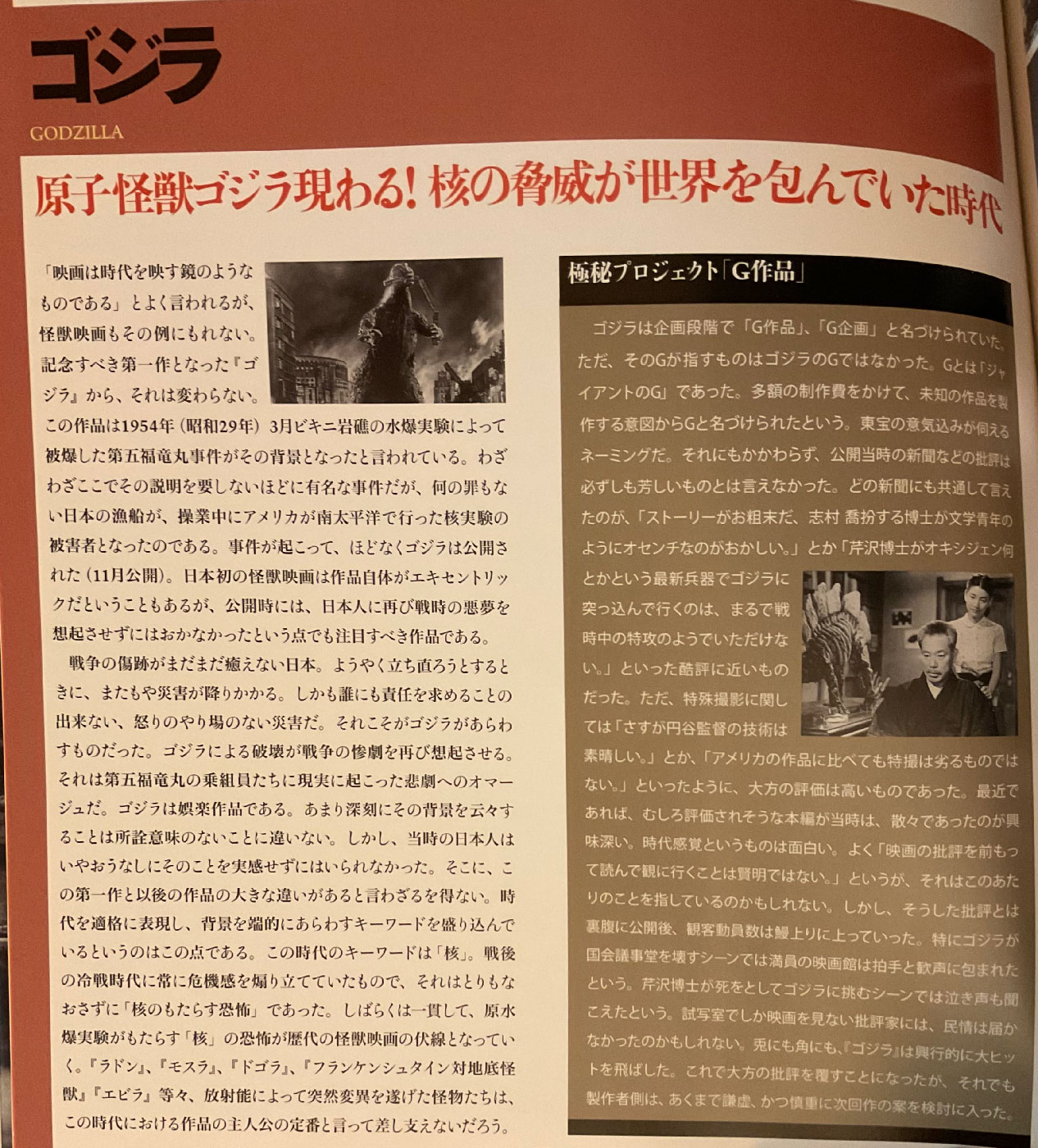5.8.2023
About Godzilla 1954

ゴジラ
Godzilla
原子怪獣ゴジラ現る!核の脅威が世界を包んでいた時代
Atomic monster Godzilla appears! An era when the threat of nuclear weapons engulfed the world
「映画は時代を映す鏡のようなものである」とよく言われるが、怪獣映画もその例にもれない。記念すべき第一作となった『ゴジラ』から、それは変わらない。この作品は1954年(昭和29年)3月ビキニ岩礁の水爆実験によって被爆した第五福竜丸事件がその背景となったと言われている。わざわざここでその説明を要しないほどに有名な事件だが、何の罪もない日本の漁船が、操業中にアメリカが南太平洋で行った核実験の被害者となったのである。事件が起こって、ほどなくゴジラは公開された(11月公開)。日本初の怪獣映画は作品自体がエキセントリックだということもあるが、公開時には、日本人に再び戦時の悪夢を想起させずにはおかなかったという点でも注目すべき作品である。
It is often said that movies are like mirrors that reflect the times, and monster movies are no exception. It hasn’t changed since “Godzilla,” the memorable first work. This work is said to have been inspired by the Lucky Dragon No. 5 Incident, which was exposed in March 1954 (Showa 29) due to a hydrogen bomb test at Bikini Reef. An innocent Japanese fishing boat became the victim of a nuclear test carried out by the United States in the South Pacific while it was fishing. Godzilla was released soon after the incident (released in November). Japan’s first monster movie is eccentric in its own right, but at the time of its release, it is also noteworthy for the fact that it once again reminded Japanese people of wartime nightmares.
戦争の傷跡がまだまだ癒えない日本。ようやく立ち直ろうとするときに、またもや災害が降りかかる。しかも誰にも責任を求めることの出来ない、怒りのやり場のない災害だ。それこそがゴジラがあらわすものだった。ゴジラによる破壊が戦争の惨劇を再び想起させる。それは第五福竜丸の乗組員たちに現実に起こった悲劇へのオマージュだ。ゴジラは娯楽作品である。あまり深刻にその背景を云々することは所詮意味のないことに違いない。しかし、当時の日本人はいやおうなしにそのことを実感せずにはいられなかった。そこに、この第一作と以後の作品の大きな違いがあると言わざるを得ない。時代を適格に表現し、背景を端的にあらわすキーワードを盛り込んでいるというのはこの点である。この時代のキーワードは「核」。戦後の冷戦時代に常に危機感を煽り立てていたもので、それはとりもなおさずに「核のもたらす恐怖」であった。しばらくは一貫して、原水爆実験がもたらす「核」の恐怖が歴代の怪獣映画の伏線となっていく。『ラドン』、『モスラ』、『ドゴラ』、『フランケンシュタイン対地底怪獣』『エビラ』等々、放射能によって突然変異を遂げた怪物たちは、この時代における作品の主人公の定番と言って差し支えないだろう。
Japan is still suffering from the scars of war. Just when you are finally on your feet again, disaster strikes. Moreover, it is a disaster with no outlet for anger, for which no one can be held accountable. That’s what Godzilla represented. Destruction by Godzilla once again reminds us of the tragedy of war. It’s a tribute to the real-life tragedy that happened to the crew of the Daigo Fukuryu Maru. Godzilla is an entertainment work. It must be meaningless to talk about the background too seriously after all. However, the Japanese people at the time could not help but realize this fact. I have to say that there is a big difference between this first work and subsequent works. This is the reason why it appropriately expresses the era and incorporates keywords that simply express the background. The keyword of this era is “nuclear.” In the post-war Cold War era, there was always a sense of crisis, and it was the ‘fear of nuclear weapons.’ For a while, the terror of “nuclear” brought about by atomic and hydrogen bomb tests has been the foreshadowing of successive monster movies. “Rodan,” “Mothra,” “Dogora,” “Frankenstein vs. Baragon,” “Ebira,” etc., monsters that have been mutated by radiation can be safely said to be the standard protagonists of works of this era.
極秘プロジェクト「G作品」
Top Secret Project “G Works”
ゴジラは企画段階で「G作品」、「G企画」と名づけられていた。ただ、そのGが指すものはゴジラのGではなかった。Gとは「ジャイアントのG」であった。多額の制作費をかけて、未知の作品を製作する意図からGと名づけられたという。東宝の意気込みが伺えるネーミングだ。それにもかかわらず、公開当時の新聞などの批評は必ずしも芳しいものとは言えなかった。どの新聞にも共通して言えたのが、「ストーリーがお粗末だ、志村喬扮する博士が文学青年のようにオセンチなのがおかしい。」とか「芹沢博士がオキシジェン何とかという最新兵器でゴジラに突っ込んで行くのは、まるで戦時中の特攻のようでいただけない。」といった酷評に近いものだった。ただ、特殊撮影に関しては「さすが円谷監督の技術は素晴しい。」とか、「アメリカの作品に比べても特撮は劣るものではない。」といったように、大方の評価は高いものであった。最近であれば、むしろ評価されそうな本編が当時は、散々であったのが興味深い。時代感覚というものは面白い。よく「映画の批評を前もって読んで観に行くことは賢明ではない。」というが、それはこのあたりのことを指しているのかもしれない。しかし、そうした批評とは裏腹に公開後、観客動員数は鰻上りに上っていった。特にゴジラが国会議事堂を壊すシーンでは満員の映画館は拍手と歓声に包まれたという。芹沢博士が死をとしてゴジラに挑むシーンでは泣き声も聞こえたという。試写室でしか映画を見ない批評家には、民情は届かなかったのかもしれない。兎にも角にも、『ゴジラ』は興行的に大ヒットを飛ばした。これで大方の批評を覆すことになったが、それでも製作者側は、あくまで謙虚、かつ慎重に次回作の案を検討に入った。
Godzilla was named “G work” and “G plan” at the planning stage. However, that G was not Godzilla’s G. G was “Giant’s G.” It is said that it was named G with the intention of producing an unknown work at a large production cost. It is a naming that shows Toho’s enthusiasm. Despite this, the criticism in the newspapers at the time of its release was not necessarily favorable. What all the newspapers had in common was, “The story is poor. It’s like a special attack during wartime.” However, with regard to the special effects, most of the comments were high, such as “As expected of Director Tsuburaya’s technique,” and “The special effects are not inferior to American works.” It is interesting that the main story, which seems to be rather appreciated if it is recent, was terrible at that time. The sense of time is interesting. People often say, “It’s not wise to read movie reviews before going to see a movie.” However, contrary to such criticism, the number of spectators soared after its release. Especially when Godzilla destroys the Houses of Parliament, the movie theater was filled to the brim with applause and cheers. In the scene where Dr. Serizawa challenges Godzilla to death, it is said that he could hear crying. The public sentiment may not have reached the critics who only saw the movie in the preview room. Surprisingly, “Godzilla” was a box office hit. This overturned most of the criticism, but even so, the producers remained humble and cautiously considered the proposal for the next work.
東宝特撮怪獣映画大全集 Godzilla Movie Chronicle, p 8.